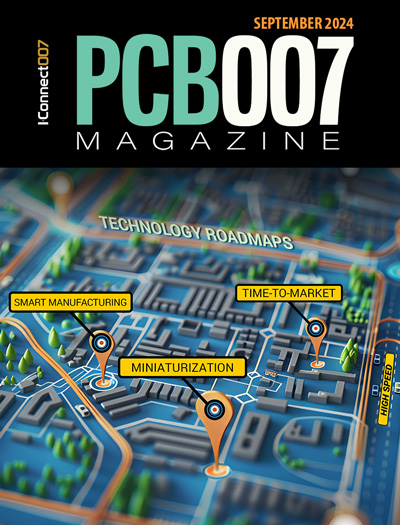-

- News
- Books
Featured Books
- pcb007 Magazine
Latest Issues
Current Issue
Engineering Economics
The real cost to manufacture a PCB encompasses everything that goes into making the product: the materials and other value-added supplies, machine and personnel costs, and most importantly, your quality. A hard look at real costs seems wholly appropriate.

Alternate Metallization Processes
Traditional electroless copper and electroless copper immersion gold have been primary PCB plating methods for decades. But alternative plating metals and processes have been introduced over the past few years as miniaturization and advanced packaging continue to develop.

Technology Roadmaps
In this issue of PCB007 Magazine, we discuss technology roadmaps and what they mean for our businesses, providing context to the all-important question: What is my company’s technology roadmap?
- Articles
- Columns
Search Console
- Links
- Media kit
||| MENU - pcb007 Magazine
Harris 3D Prints RF Amplifiers Using Nano Dimension’s DragonFly Pro
November 7, 2018 | Globe NewswireEstimated reading time: 3 minutes
In a major breakthrough for additive manufacturing for printed electronics, tests conducted by Harris Corporation showed 3D printed radio frequency (RF) circuit performance is comparable to that of circuits developed using conventional manufacturing techniques. Harris selected Nano Dimension, a leading additive electronics provider and its multi-material DragonFly Pro 3D electronics printer to produce the functional circuits in a single print. The study on the advantages of using additive manufacturing to develop RF circuits for wireless systems is part of a joint project with the Israel Innovation Authority and Space Florida Foundation, a partnership promoting research, development and the commercialization of aerospace and technology projects.
Harris is a leader in the development of RF circuits for electronic warfare and communications systems. In recent years, developing these circuits and systems used for conveying information such as data, video and voice across long distances, has focused on improving mobility and performance. Harris also has focused on reducing development time and cost which typically is a long, complex multi-stage process when using conventional manufacturing methods.
"Harris looked at the applicability of 3D printing for developing RF systems, and then designed, simulated and tested the 3D printed RF amplifier and compared it with an amplifier fabricated using conventional manufacturing techniques,” said Arthur Paolella, PhD, senior scientist, Space and Intelligence Systems, Harris Corporation. “Our results showed similar RF performance between the 3D printed version and the baseline amplifier, clearly demonstrating the viability of 3D printed electronics for RF circuitry.”
“The use of in-house 3D printed electronics to make antennas is a breakthrough, in terms of the time and cost of prototyping and proofs-of-concept,” said Amit Dror, CEO of Nano Dimension. “In addition, 3D printed electronics makes possible development of even smaller and lighter antennas that have rigid packaging integrated with flexible circuits, without the need for cables and connectors.”
The Nano Dimension DragonFly Pro is a multi-material, extremely precise inkjet deposition 3D printing system that incorporates conductive silver inks and dielectric inks to create functional electronic parts in a single print.
Harris will present the full details of its findings at the IEEE Radio and Wireless Symposium in January.
In June 2017, Nano Dimension received an Israel Innovation Authority grant approval to finance a project to develop 3D printing of electronical modules for space applications in collaboration with Harris. The grant project was designed to demonstrate potential that 3D printing double sided, multilayer circuits that distribute digital, power and RF signals could reduce size, weight, power and cost of space systems.
The DragonFly 2020 Pro 3D printer transforms electromechanical development by empowering companies to take control of their entire development cycle. The system enables the 3D printing of functional electronics such as encapsulated sensors, conductive free-form geometries, antennas, molded connected devices, printed circuit boards and other innovative devices.
About Harris Corporation
Harris Corporation is a leading technology innovator, solving customers’ toughest mission-critical challenges by providing solutions that connect, inform and protect. Harris supports government and commercial customers in more than 100 countries and has approximately $6 billion in annual revenue. The company is organized into three business segments: Communication Systems, Electronic Systems and Space and Intelligence Systems.
About Nano Dimension Ltd.
Nano Dimension is a leading electronics provider that is disrupting, reshaping, and defining the future of how cognitive connected products are made. With its unique 3D printing technologies, Nano Dimension is targeting the growing demand for electronic devices that require increasingly sophisticated features. Demand for circuitry, including PCBs - which are the heart of every electronic device - covers a diverse range of industries, including consumer electronics, medical devices, defense, aerospace, automotive, IoT and telecom. These sectors can all benefit greatly from Nano Dimension’s products and services for rapid prototyping and short-run manufacturing. For more information, please click here.
Suggested Items
Kimball Electronics "Pinks the Town with Soup Fundraiser to Support Breast Cancer Awareness
11/27/2024 | Kimball ElectronicsKimball Electronics recently held a successful fundraiser to support breast cancer awareness, partnering with the Memorial Hospital Foundation to provide life-saving mammograms to patients in need.
sureCore Now Licensing its CryoMem Range of IP for Quantum Computing
11/26/2024 | sureCoresureCore, the memory specialist, has announced that it is now licensing its CryoMem™ suite of Memory IP that is designed for use at the extremely low temperatures required for Quantum Computing (QC) applications.
IPC Japan Puts More Focus on Collaboration, Standards Development, Advanced Packaging
11/26/2024 | Yusaku Kono, IPC Japan RepresentativeIn the past year, IPC has strengthened its relationships with key Japanese companies and government bodies. This was accomplished, in part, by a visit to Japan this past summer, where members of the IPC Asia team, punctuated by standards committee work last winter, forged stronger ties with government officials and companies involved in electronics manufacturing.
Subdued Electronics Industry Sentiment Continues in November
11/25/2024 | IPCIPC releases November 2024 Global Sentiment of the Electronics Manufacturing Supply Chain report
NEOTech Significantly Improves Wire Bond Pull Test Process
11/25/2024 | NEOTechNEOTech, a leading provider of electronic manufacturing services (EMS), design engineering, and supply chain solutions in the high-tech industrial, medical device, and aerospace/defense markets, proudly announces a major advancement in its wire bond pull testing process, reducing manufacturing cycle time by more than 60% while maintaining industry-leading production yields of over 99.99%.


